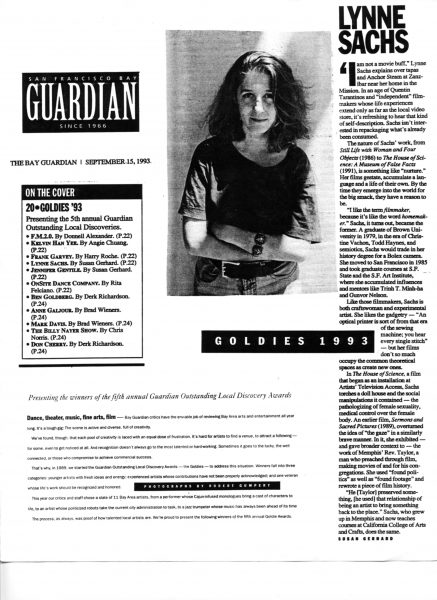
“I am not a movie buff,” Lynne Sachs explains over tapas and Anchor Steam at Zanzibar near her home in the Mission. In an age of Quentin Tarantinos and “independent” filmmakers whose life experiences extend only as far as the local video store, it’s refreshing to hear that kind of self-description. Sachs isn’t interested in repackaging what’s already been consumed.
The nature of Sachs’ work. From Still Life with Woman and Four Objects (1986) to The House of Science: A Museum of False Facts (1991), is something like “nurture.” Her films gestate, accumulate a language and a life of their own. By the time they emerge into the world for the big smack, they have a reason to be.
“I like the term filmmaker because it’s like the word homemaker.” Sachs, it turns out, became the former. A graduate of Brown University in 1979, in the era of Christine Vachon, Todd Haynes, and semiotics, Sachs would trade in her history degree for a Bolex camera. She moved to San Francisco in 1985 and took graduate courses at S.F. State and the S.F. Art Institute, where she accumulated influences and mentors like Trinh T. Minh-ha and Gunvor Nelson.
Like those filmmakers, Sachs is both craftswoman and experimental artist. She likes the gadgetry– “an optical printer is sort of from the era of the sewing machine; you hear every single stitch” – but her films don’t so much occupy the common theoretical spaces as create new ones.
In the HOuse of Science, a film that began as an installation at Artists’ Television Access, Sachs torches a doll house and the social manipulations it contained– the pathologizing of female sexuality, medical control over the female body. An earlier film, Sermons and Sacred Pictures (1989) overturned the idea of “the gaze” in a similarly brave manner. In it, she explained– and gave broader context to – the world of Memphis’ Rev. Taylor, a man who preached through film, making movies for his congregations. She used “found politics” as well as “found footage” and rewrote a piece of film history.
“He [Taylor] preserved something, [he used] tjay relationship of being an artist to bring something back to the place.” Sachs, who grew up in Memphis and now teaches courses at California College of Arts and Crafts.
Susan Gernard
